Dearest Fellow Earthlings,
Belated May Day/Beltane Blessings to You! I hope you are surrounded by greening and celebrating life’s spring return.
I missed writing for you in April. Focus and time have been a little harder to come by than usual.
We have a lot going on, don’t we? The fullness of having relationships and work and tasks that need doing, all layered with an intensifying existential crisis and the infuriating tragedy of bold meanness and chaos that unfolds each day, issued forth from our government (US) and their supporters.
When do we have enough time and interior space to really stop and listen to what wants to be written, or made, or sung, or planted, or held, or to call a beloved and have a conversation? How can we NOT have time for these things that matter the most?
The only way is to do it . . . though the world clamors. So here I am, with beating heart and deep breaths, settling in the midst of a storm that rages, trying to quiet enough to listen. I have my little candle lit and my husband is with the puppy . . . and I’m so glad to finally be here in this space right now.
The Bloodroot
For the first time in years, I missed the blooming of Bloodroot (Sanguinaria canadensis) in my own backyard.
By the time I remembered to go out and look for the flower buds rising up through tightly curled leaves, the starry, white blossoms had already presented their gift of rich, yellow yolks of pollen to the early bees, and given their petals back to the earth. Now the soft, lobed leaves are completely unfurled, wide hands fully open to the Sun.
Bloodroot, is a spring ephemeral. It is singular, the sole member of the genus, Sanguinaria, which is derived from the Latin, sanguinum, meaning “bloody”. They’re named for the red sap that oozes from their roots and leaves if something injures them.
I was disappointed that I missed those flowers, however, I discovered another lovely thing as I walked around our yard: I could see several new patches of showy Bloodroot leaves, some of them pretty far from the original bed.
This is the kind of abundance that occurs when space is provided for life to have its lively way. Overall, the population increased threefold since last year. I knelt down near one of the spreading patches and gently touched those beautiful leaves. I know how important it is to have early bloomers like Bloodroot and Skunk Cabbage, to support early pollinators when they awaken from their winter slumber.
The moment when something comes along at just the right time feels like a blessing. Finding the spreading colonies of Bloodroot in my own back yard at this time when I am often feeling despair for the world, was such a moment. It was an image of hope and grounding.
And walking in the Heart Wood also offers much needed grounding, even if that grounding is sitting for a while with sorrow, injustice and clarifying anger.
Entering Heart Wood in Spring
If you live in the north in this season, the advent of spring is a vivid, multi-sensory experience of rebirth. At a deep gut level, it makes sense that hundreds of millions of people throughout the world, of many cultures and faiths, celebrate rebirth and resurrection as the Earth quickens with life again.
We know how fleeting this transitional moment is and we want to be with its bright new shoots of green and spring’s ephemeral blossoms, nourished by fresh rain. We are renewed with birdsong and baby animals, the sensation of bare arms in a warm breeze, and the generosity of lingering outside to talk with neighbors as day extends into the evening.
As I walk the trail that leads into the Heart Wood, textured layers of green rise on either side. When I get to the top of the hill that brings me into the forest, I hear more songs as birds lustily call to one another in bursts from the trees, each singing their questions and answers in the particular notes and cadence of their own species. Their music expresses deep dreams for future nestlings.
In these last six weeks, in my sporadic walks in these woods, I’ve felt grateful to see life quickening in the swelling of leaf buds. I saw the red maple flowers and yellow oak catkins at the height of their blossoming, and then a week later I found them on the ground faded and turning to dry husks.
Now, the Maple samaras, acorns and other tree nuts and seeds are forming and falling. Tender young leaves have opened and they spread their wrinkled faces to the sun. The canopy is blushing with sprays of earthy red, pink-tinged-green, ochre, and bright spring-green.
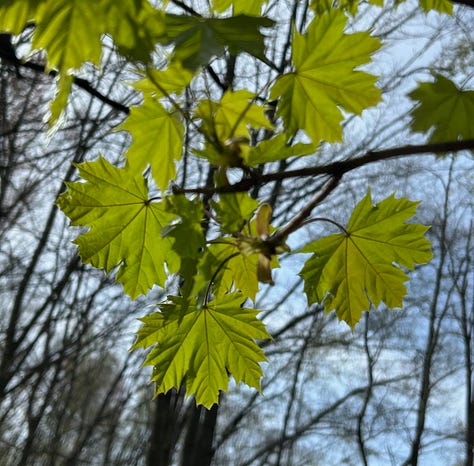
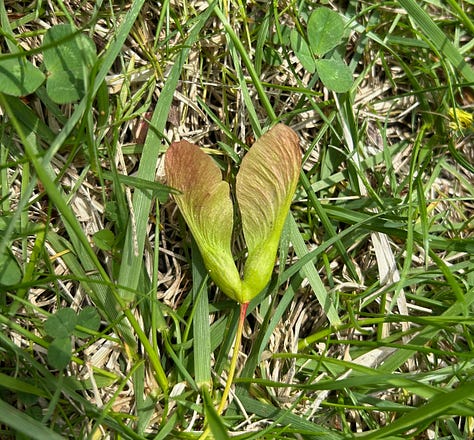
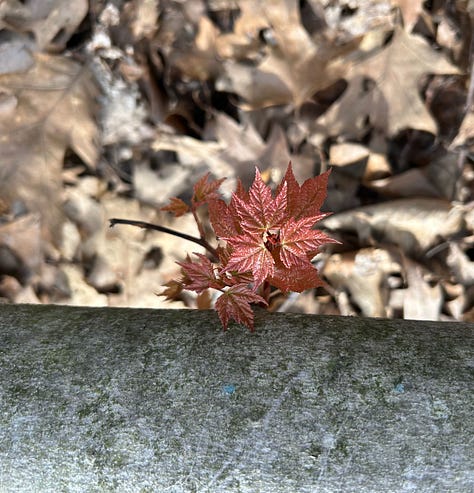
In Heart Wood Chapel
The place that I call the Chapel, is within a band of the forest about halfway along the two-mile loop trail that I walk. This part of the forest is narrow because it is on the slope of a glacial ridge with a golf course fairway above it and another below it.1
The Chapel has a good place to sit for a while: a broad fallen tree trunk that lies right along the side of the trail. Its breadth tells a story that names it as one of the older trees that once stood here. I don’t know what kind of tree it was, but it has many tall Sassafras, Maple and Wild Cherry neighbors that stand nearby.
If I look to my left or my right, I see layers of deep woods. When I sit still for a long time, Deer often wander in and stand, looking at me as I look at them. Sometimes when I walk in, I accidentally startle them. They leap off, their white tails flagging as they go.
When I lie down lengthwise on this long trunk and look up, I see the canopy of branches. I have noticed the way they all reach toward one another, maintaining a narrow space between their branches that traces the shape of their reaching. On a day in late April, that space between was just beginning to fill with young leaves.
Sitting on this tree trunk gives me an immediate view, straight ahead, of a great number of fallen trees, lying toppled upon one another. Beyond the fallen, if I stand up on the stump and look down the slope and over a narrow bit of wetland, I can see the weird, unnatural expanse of the manicured green of one large fairway. Sometimes there is a person in a golf cart moving quickly, rushing by to get to the next hole.
When I look to my left as I sit, there is a formation of fallen trees that evokes the image of someone, bent over and carrying a great burden.
I feel it is imperative for us not to shy away from what disturbs us: our sorrow, anger and the pain of our own culpability. These are the feelings that can galvanize us for necessary work, especially if we want to be a part of change for the good of all. But we need to be careful not to take on the whole burden or we fall into despair. I need solitude to meditate on both love and generativity and the hard realities of loss and injustice. And I need community in order to be engaged with the work of repair and healing.
I call this place The Chapel because it is a precise location where I can’t help but feel the deep convergence of love and loss, peace and joy, lamentation and longing. All of these exist in my long relationship with the Heart Wood, and are present each time I go.
The affection I have for the beauty and life of this forest inhabits the same heart that feels real grief and rage for so much that has been despoiled for the sport of a few privileged humans who appreciate a rambling golf course surrounded by nature for their own pleasure. It was made at the end of the 1990s as a vanity project for a wealthy donor to the university.
Holy Week in Heart Wood
Part 1: An Iconic Christian Story
I visited the Heart Wood twice during Holy Week (April 20-27), a week in the Christian tradition that commemorates the last seven days of Jesus’ human life and then his defeat of death by rising, fully alive, from the grave on Easter. I sat on my fallen tree and reflected on the stories of what transpired through the course of that week in Jerusalem over 2000 years ago. There are always elements of this story, as in any sacred, iconic tale, that feel deeply relevant, but in this current moment, as I sat there on my log, the events felt like a flaming beacon.
I want to briefly retell the events of this story, to be read here through a lens of right now. Even if you have no religious inclination, elements of the story will be familiar, but will not be delivered here with religious fervor. There is no need to believe any particular thing here. If you have suffered wounds from religion, or have lost any shred of respect for Christianity because of the cruel and Orwellian ways it is being used as a tool right now, I ask that you try to approach this with a fresh view. This is about being good humans upon the Earth, something that some who are in power don’t seem very interested in being.
The story goes like this: Jesus came to Jerusalem on a Sunday to celebrate the festival of Pasach (Passover), a commemoration of the deliverance of the Jewish people out of the bondage of slavery in Egypt and into freedom. He came, as many Jewish people did then and still do, to Jerusalem for the holiday because that is where the Temple was.
Had had collected thousands of followers as he traveled through the country side and crossed waters in fishing boats with his disciples, passionately preaching an anarchic message about loving God, one another, and the stranger. He modeled living simply and compassionately, within generous mutuality, affirming that there is abundance when we share. He exposed the false power of the colonizing Roman authorities and the hypocrisy of some of the Temple Priests who pandered to them, hungry for their own shreds of power in a disempowering situation under the heel of the militaristic, early capitalism of the Roman Empire. His impassioned listeners heard the truth in his words. They were seen as they were, and clamored for his words of justice. Many of them needed his healing touch—the touch of compassionate love and care.
On that Sunday, Jesus rode through the gate of Jerusalem on the back of a small donkey, greeted by throngs of adoring followers who laid their garments on the path before him and waved palm fronds as they sang their joy. The Roman and Temple authorities were a bit nervous. Perhaps Jesus also felt a bit unsettled by this attention.
The next day, Monday, Jesus went to the Temple and saw that it was being used for commerce. He angrily flipped over the tables of the merchants and bankers who had turned the Temple into a market for their profit during the holiday. He called them out for defiling the sacred with their greed.
It is likely that he retreated to the home of some friends—Martha, Mary and Lazarus in nearby Bethany—for some rest and to lie low for a few days after that event on Monday. Perhaps it was during that time that his friend Judas made arrangements to betray him to the Romans for a sum of money.
On Thursday evening, Jesus invited his closest friends to a Seder dinner in a borrowed room. He tenderly washed their feet, told them that he loved them and fed them bread and wine. Then Jesus asked a few of them to remain with him in the olive grove at Gethsemane, keeping watch through the night for the Roman soldiers, who were on their way to arrest him. His friends fell asleep while he cried to God for mercy among the trees.
The soldiers came at dawn on Friday and arrested him in the Garden. He did not receive a fair trial—there was no due process. He was taunted and brutalized, and denied by some who loved him. Then he was slowly tortured to death that afternoon in a horrific public lynching.
I imagine the immediate silence after death. And then the deep cries of grief, and anxiety and the shame of culpability.
Easter, the day that celebrates Jesus’ return from the dead, gets the most focused attention among many church goers, but these are Holy Monday, Maundy Thursday, Good Friday, and Saturday Vigil times. The crucifixion of Christ,2 as the Holy that dwells within the Living, is ongoing, happening through the centuries, and is here and now, today. (please see footnote for some clarification)
And resurrection is also present as long as Life exists. Life everlasting is continuous in successive generations of bodies, all of the bodies of the living on Earth, which fully includes us, entangled together in mutuality, each mysteriously inspirited. All life was originally and miraculously birthed and enlivened without human engineering, business strategy, or religion. The Kin-dom of Heaven is here, among us. We just need the scales to fall from our eyes in order to see it.
Part 2: Here and Now
“Pray for the dead and fight like hell for the living.”
~Mother Jones
I sat there on the body of what had been a giant, and looked out at the pile of fallen trees before me. They had grown from seeds in this soil, sheltered from the wind by the depth of a forest whose layers of trees held one another up in shared presence. The most deeply rooted are those that stand at the edge, buffering the elements for the others. Without those who strongly formed at the margins, storms and winds topple more and more of the trees within the forest.
I thought about how golf season would begin soon, and spiffy, mostly wealthy white people in their golf outfits would tootle around in electric carts over the 600 acres of golf course. They would stop at huge swaths of outrageously and meticulously manicured turf to hit tiny balls into holes from various distances.
I pictured that vibrant second-growth forest as it had been up until 1998 and remembered standing within it and only seeing forest in every direction. A thriving community that had grown together for a couple of centuries, with Mother trees and their myriad offspring and all the others living near, in, on, under and among them. I imagined the vast, interconnected web of fungal mycorrhizae and root systems, teeming microbes and diverse invertebrates, that made the richness of the soil and enabled countless lives. It takes a hundred years for a forest to become a vibrant ecosystem that can be destroyed in days.
I thought of current State terror and those who, in this time right now, have been and are being kidnapped, taken forcibly out of the life they were living. On any given day in the US now, people are being illegally whisked away from their families and friends by US government ICE agents, without due process, all because they are brown and were born someplace else. Hundreds have been walked brutally onto planes, transported to and then locked away in an overcrowded mega-prison in El Salvador, that our government paid six million dollars for. A concentration camp from which we are told none can be recovered.
I thought of universities and schools of every level that have been instructed that they can no longer immerse in critical thinking, true scientific research, and facts that challenge us to grow. This government wants to oversee the curriculum. Teachers at all levels, are being told they cannot care for all of their students by seeing and valuing who they are.
Images of Earth laid to waste by extractive machinery arose, and the reality of so many living beings, including humans, separated, perishing from the lack home, safety, resources, respect and care. Dying of genocidal war. Dying from ecocide. Dying from lack of actualized love.
I too am implicated in these horrors, because I live in this country, and in the Global North. We did not stop this from happening. I’m sad and afraid that what we can do might be too late and not nearly enough. But I believe that the gift of life is sacred, and I know I am far from alone in that. We need to keep on loving and trying, however each of us is able.
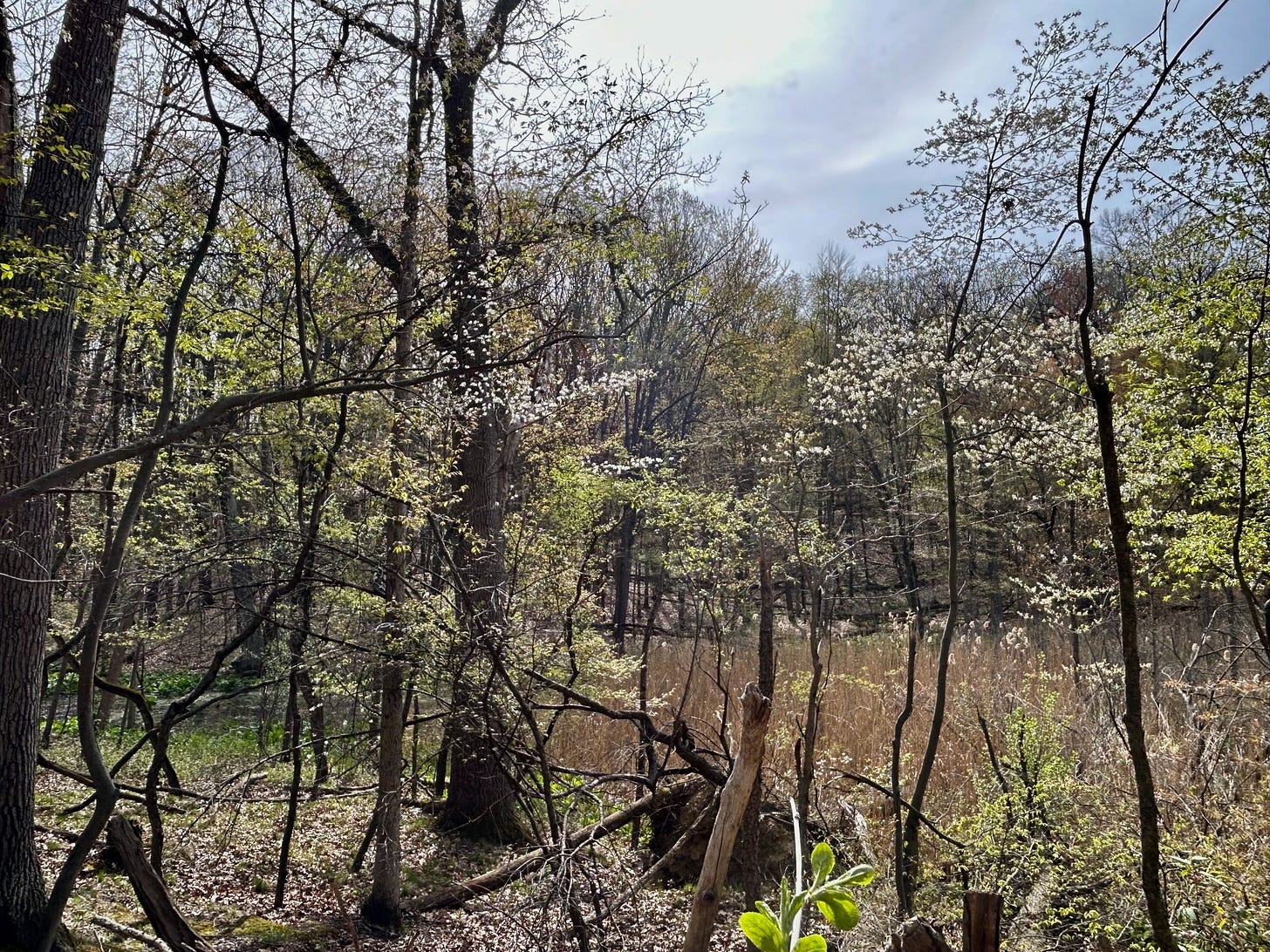
Palms on the Damp Earth
As the leaves in the tree canopy mature over the next couple of weeks, sunlight will diminish for the Bloodroot. The growth of their wide, open leaves will slow and stop. By Summer Solstice, the Bloodroot leaves will have withered and died, having fulfilled their lives by feeding the roots and the developing seeds through their photosynthetic dance with the air and sunlight. New leaves will rise again next spring. New bees will pollinate them.
Several days after I found those new colonies of Bloodroot in my back yard, I was reminded in an email of the following words by, environmentalist and essayist, Kathleen Dean Moore:
I don’t know any other way to move through darkness, but to put one foot ahead of the other and listen for the exact sound of our footsteps. If we have to drop to our knees sometimes and press the palms of our hands against the duff and damp of the Earth, then that is what we will do.3
This is a kind of embodied prayer that makes sense to me and breathes on the coals of my heart. I do hear the sound of footsteps and a couple of those feet are mine, walking in the midst.
The path ahead is not an easy one, but it is more manageable when we gather together.
May fierce and strong, abiding Love prevail within and among us.
Amen
For more of the story about the loss of much of this woodland for a golf course, please see Welcome to the Heart Wood
Now I am getting theological: contemporary mystic and Franciscan Friar, Richard Rohr teaches that Christ is not just Jesus’ last name, but an indication that he was “fully human, and fully divine”. He writes: “Christ is the eternal amalgam of matter and spirit as one. They hold and reveal one another. Wherever the human and the divine coexist, we have the Christ. Wherever the material and the spiritual coincide, we have the Christ.” For more, see: You Are the Body of Christ; The Ever Expanding Universe
In Kathleen Dean Moore’s beautiful collection of essays: Wild Comfort: The Solace of Nature, Boston: Trumpeter Books, 2010, p. 60 in the piece entitled, “Overnight Fog in the Valley”.




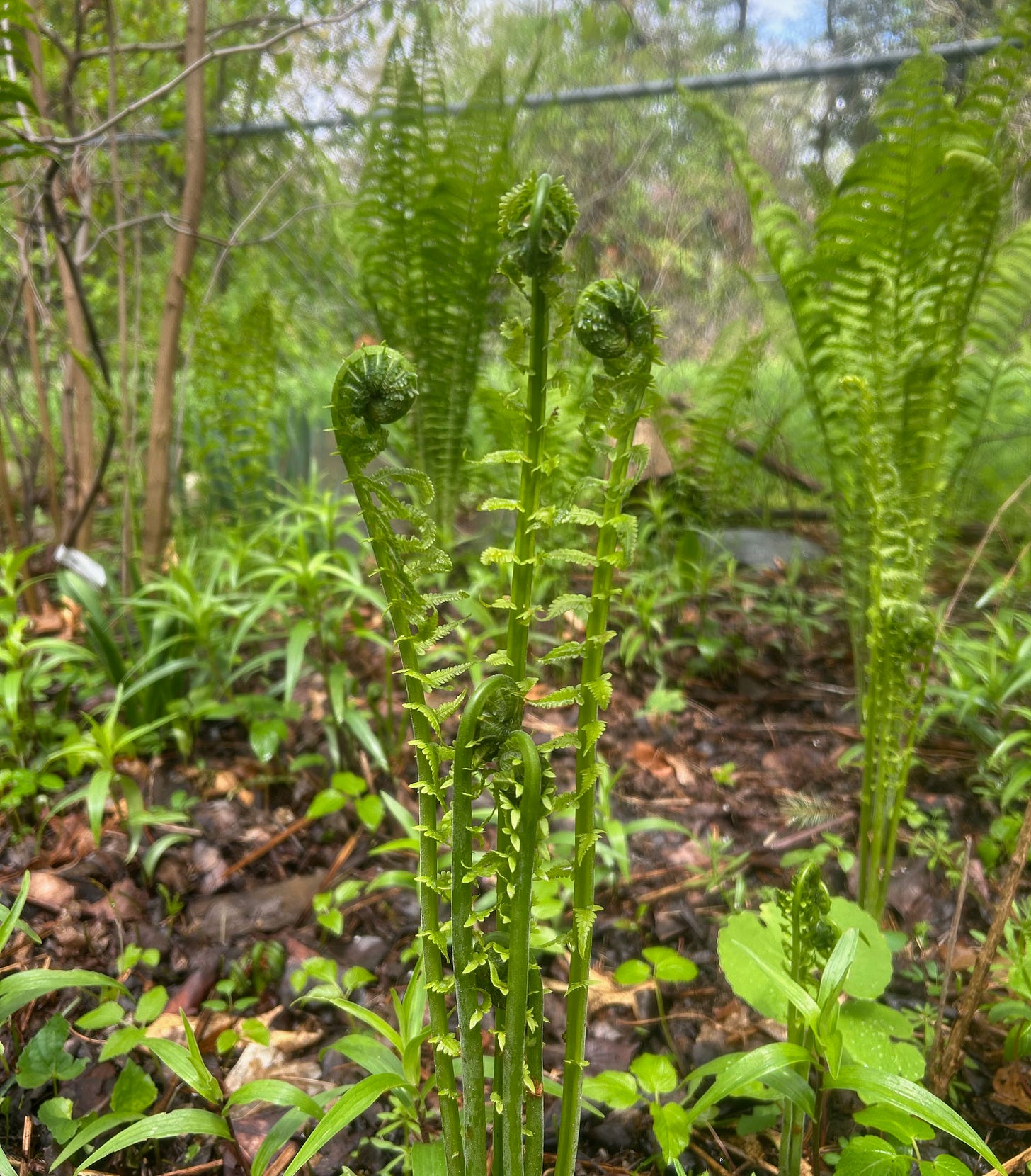
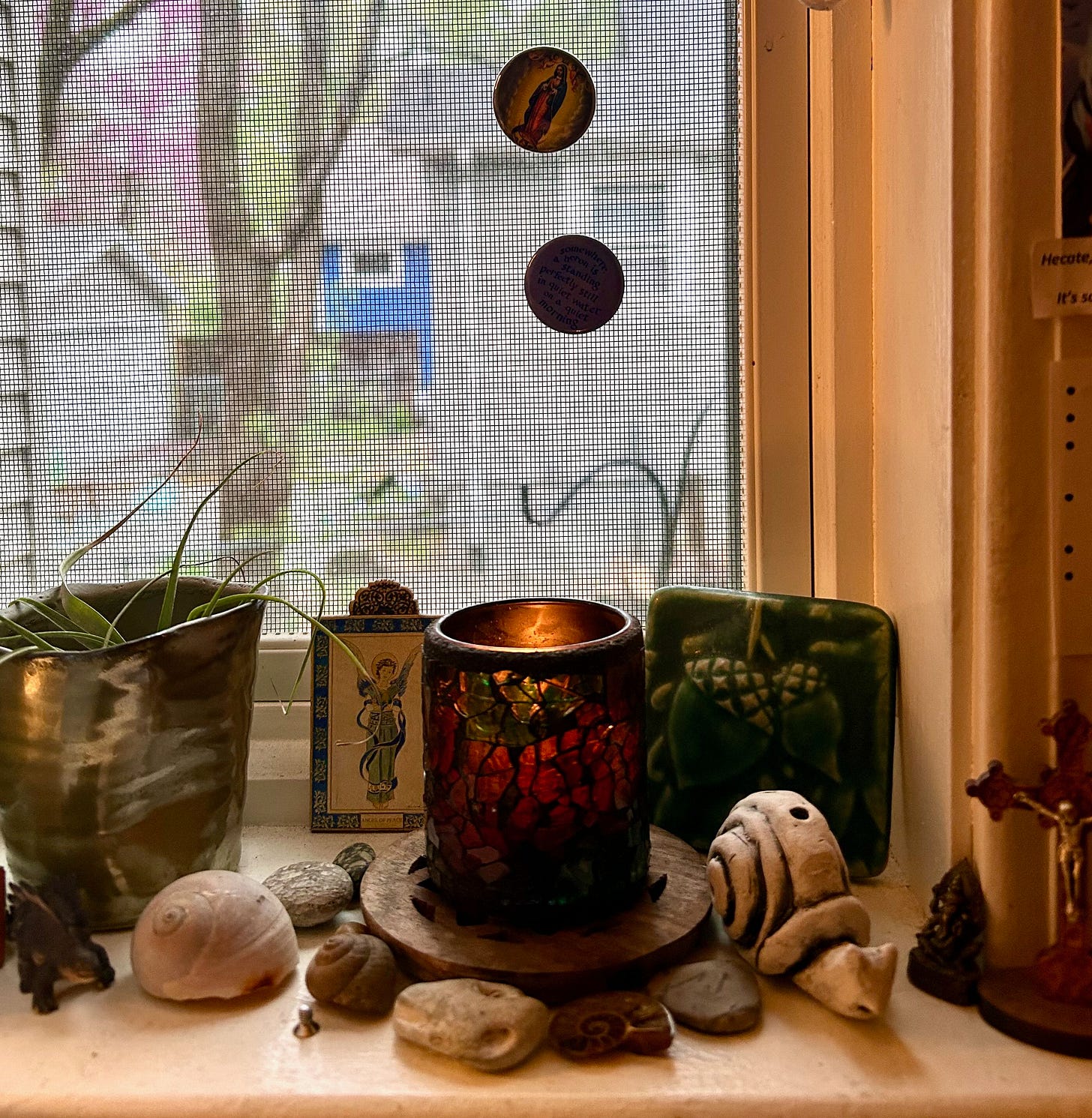
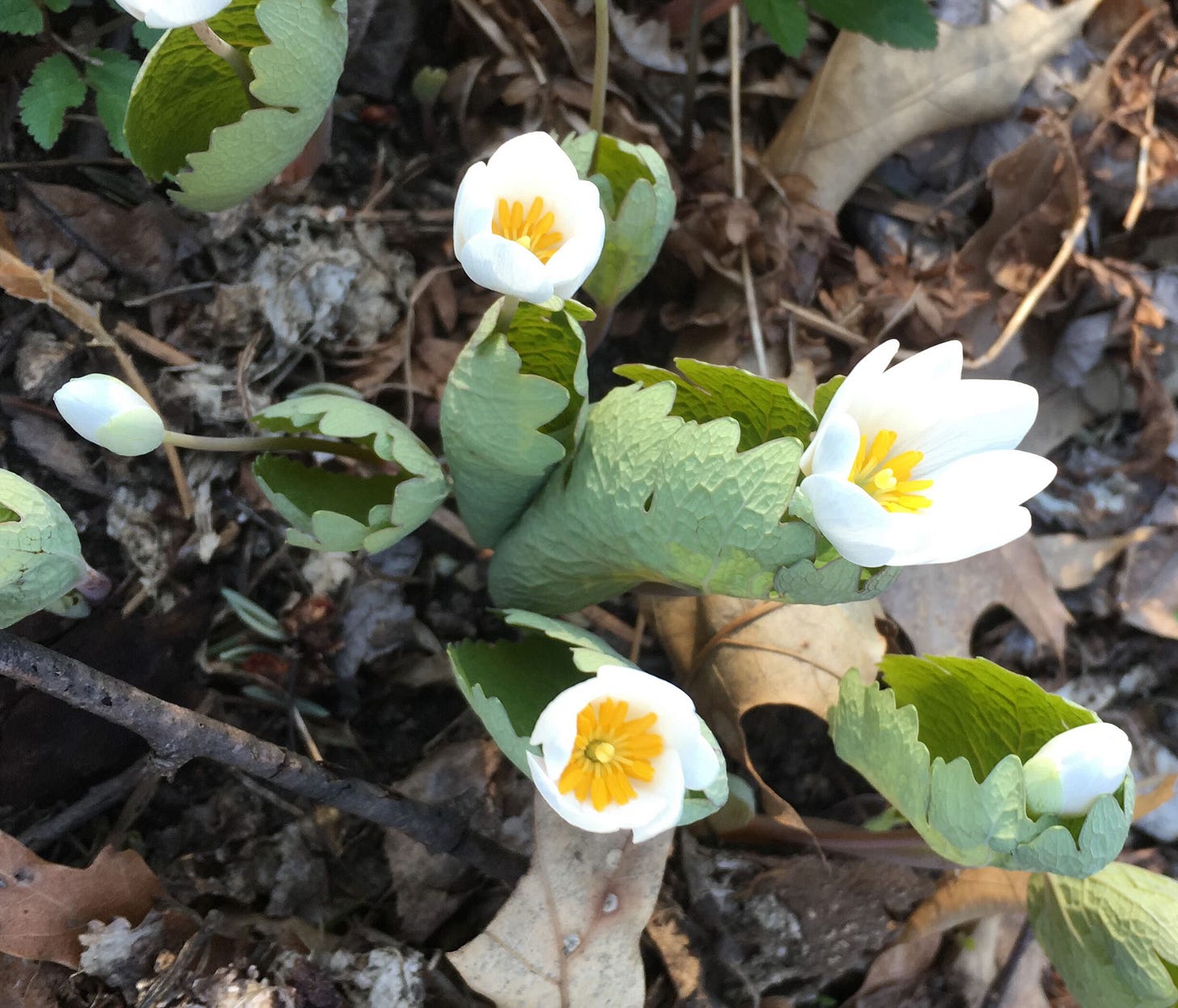
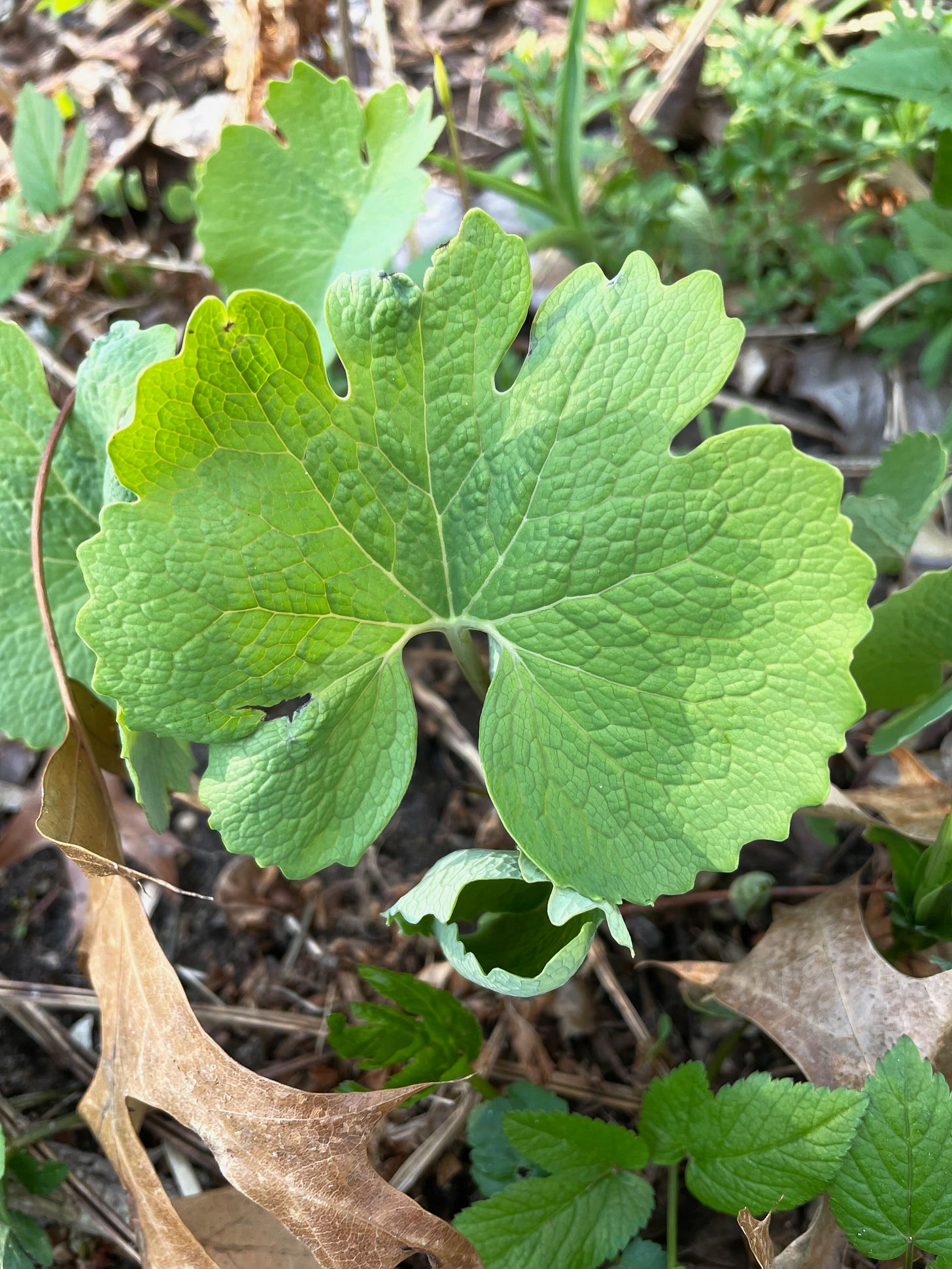
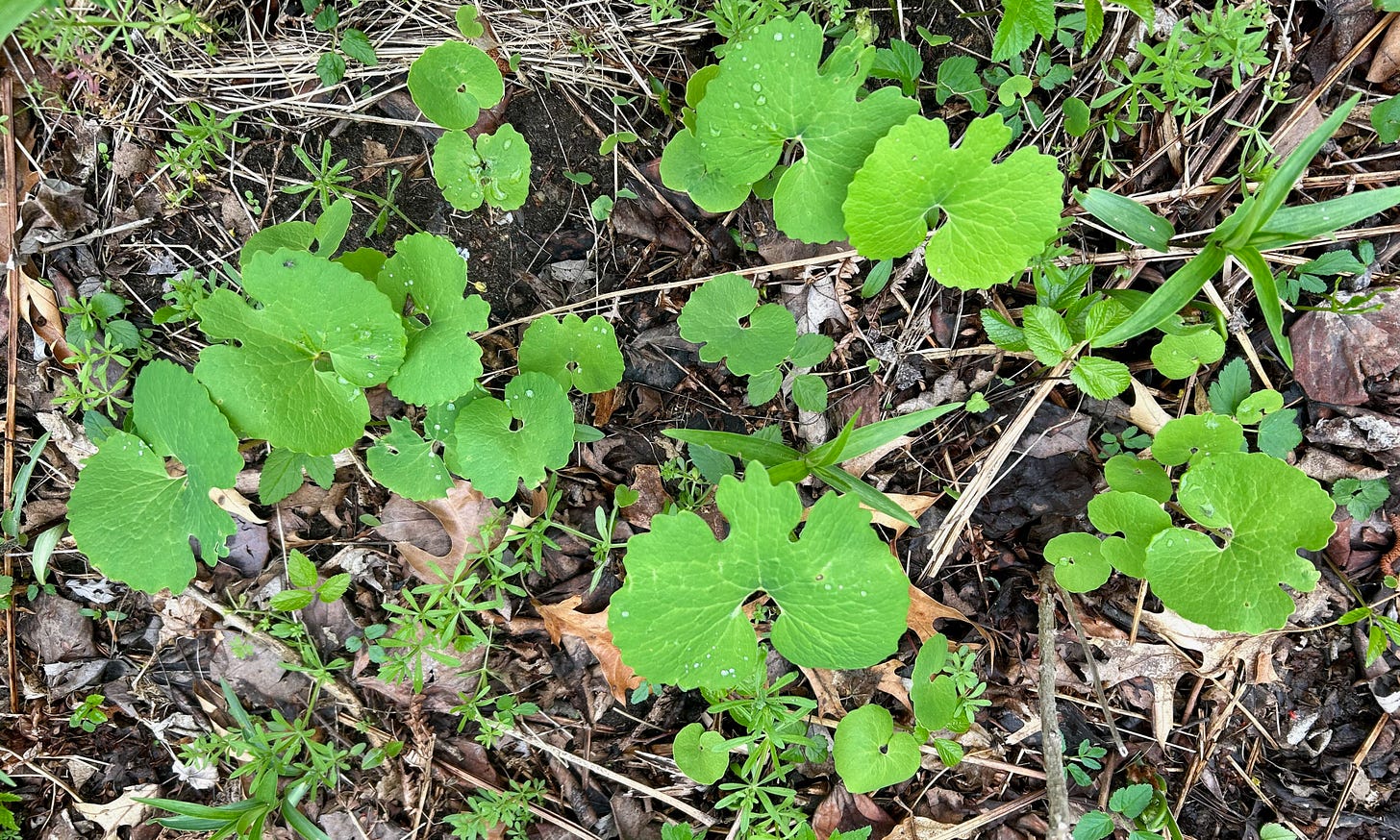
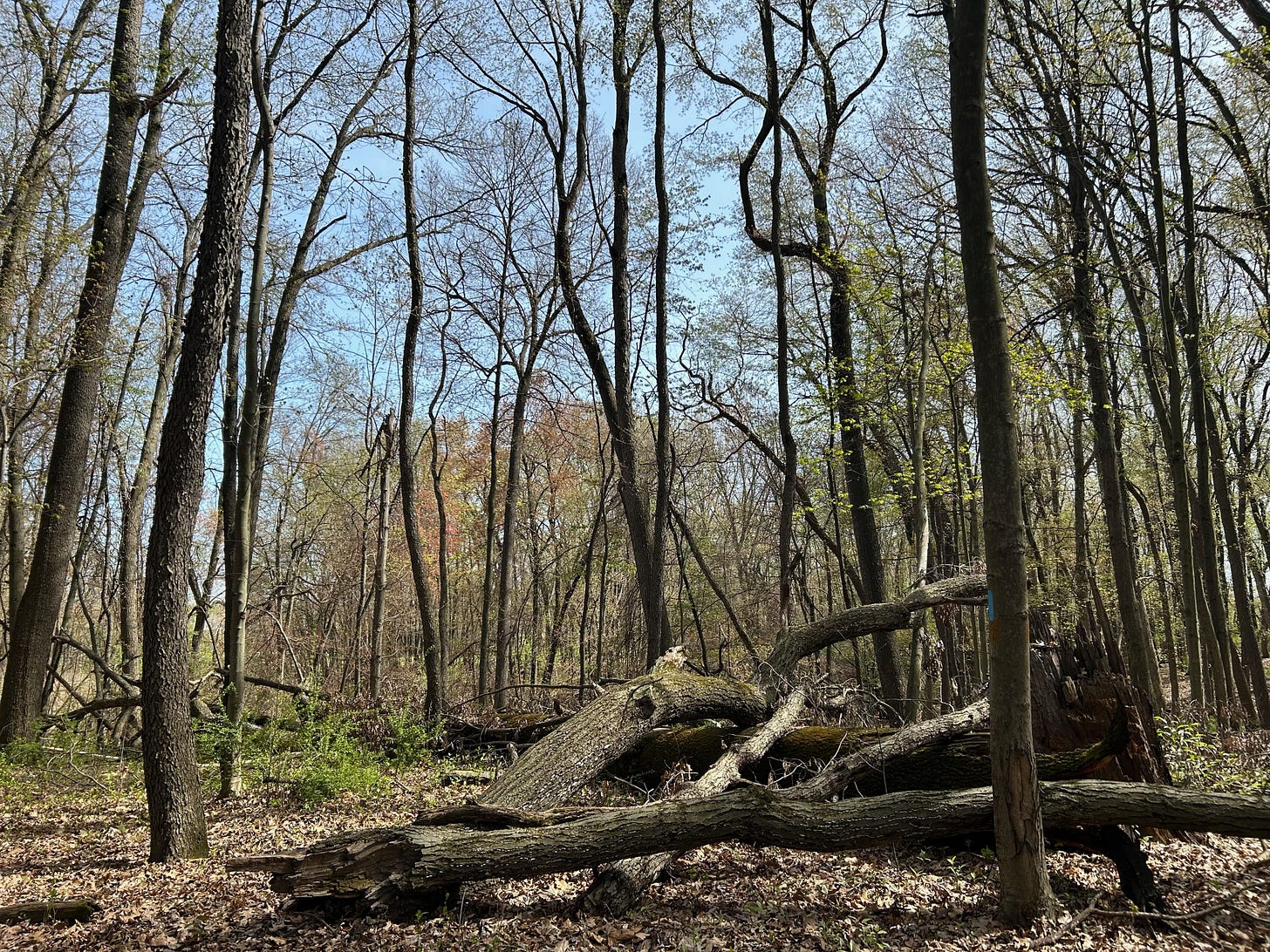
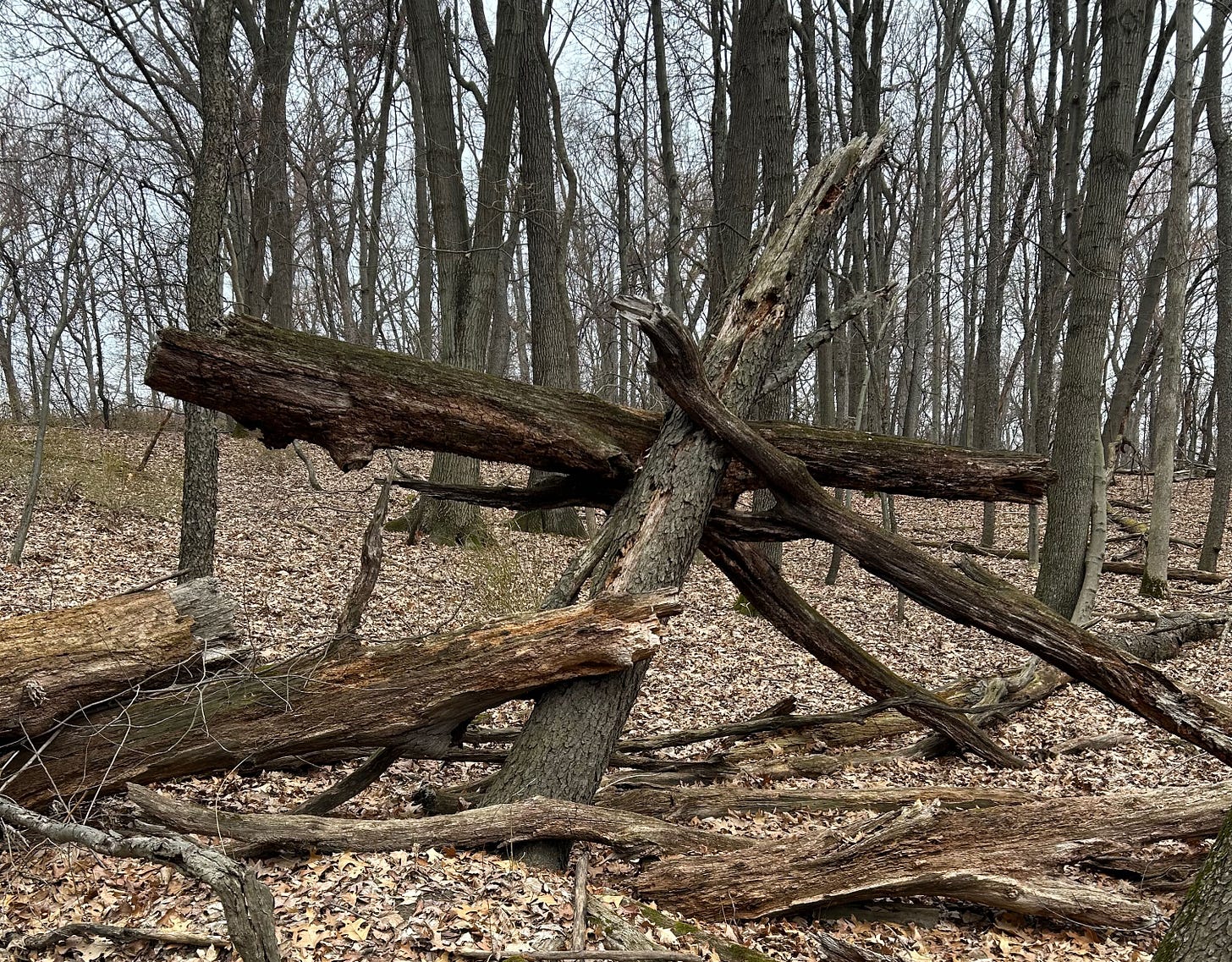
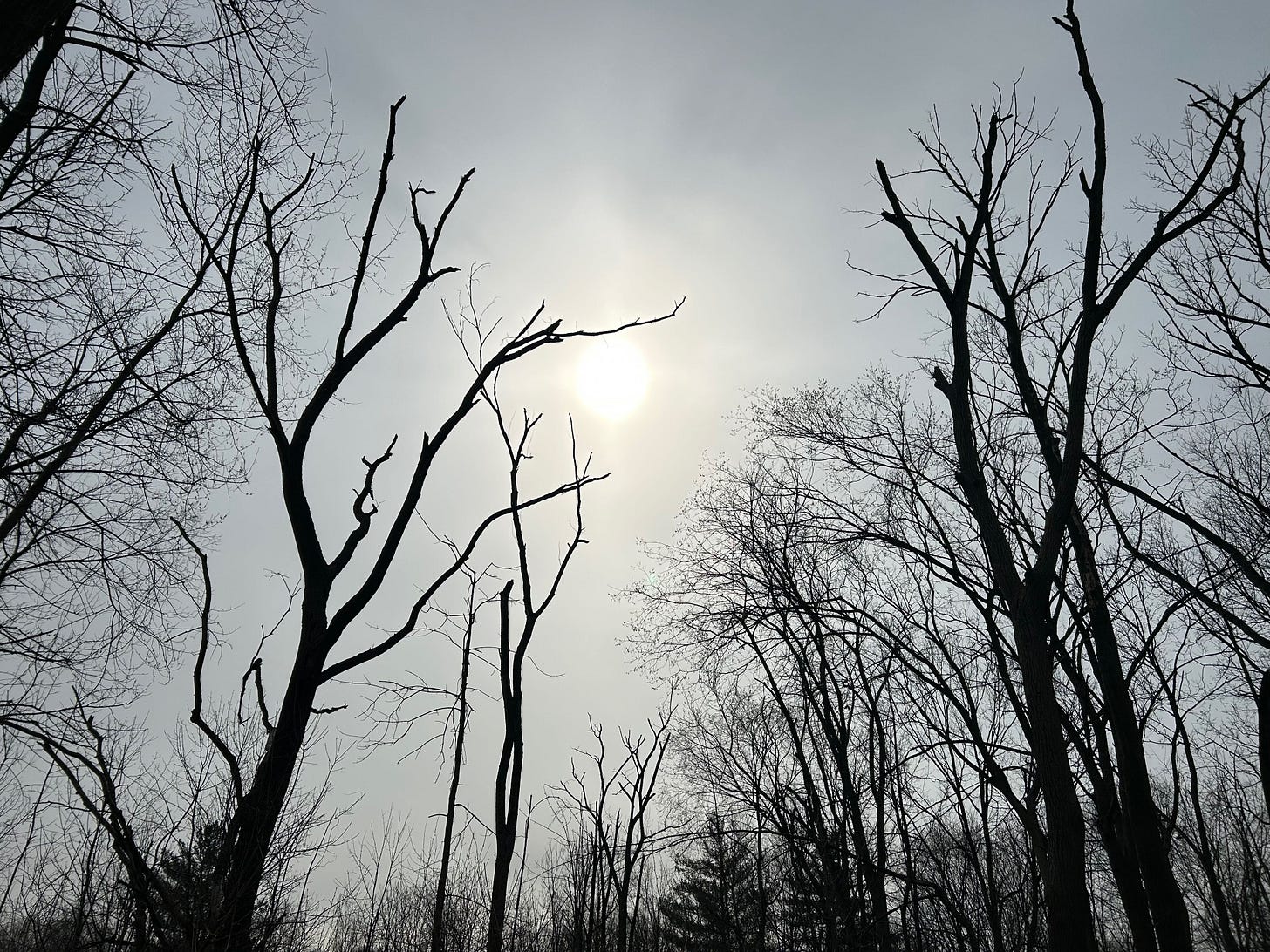
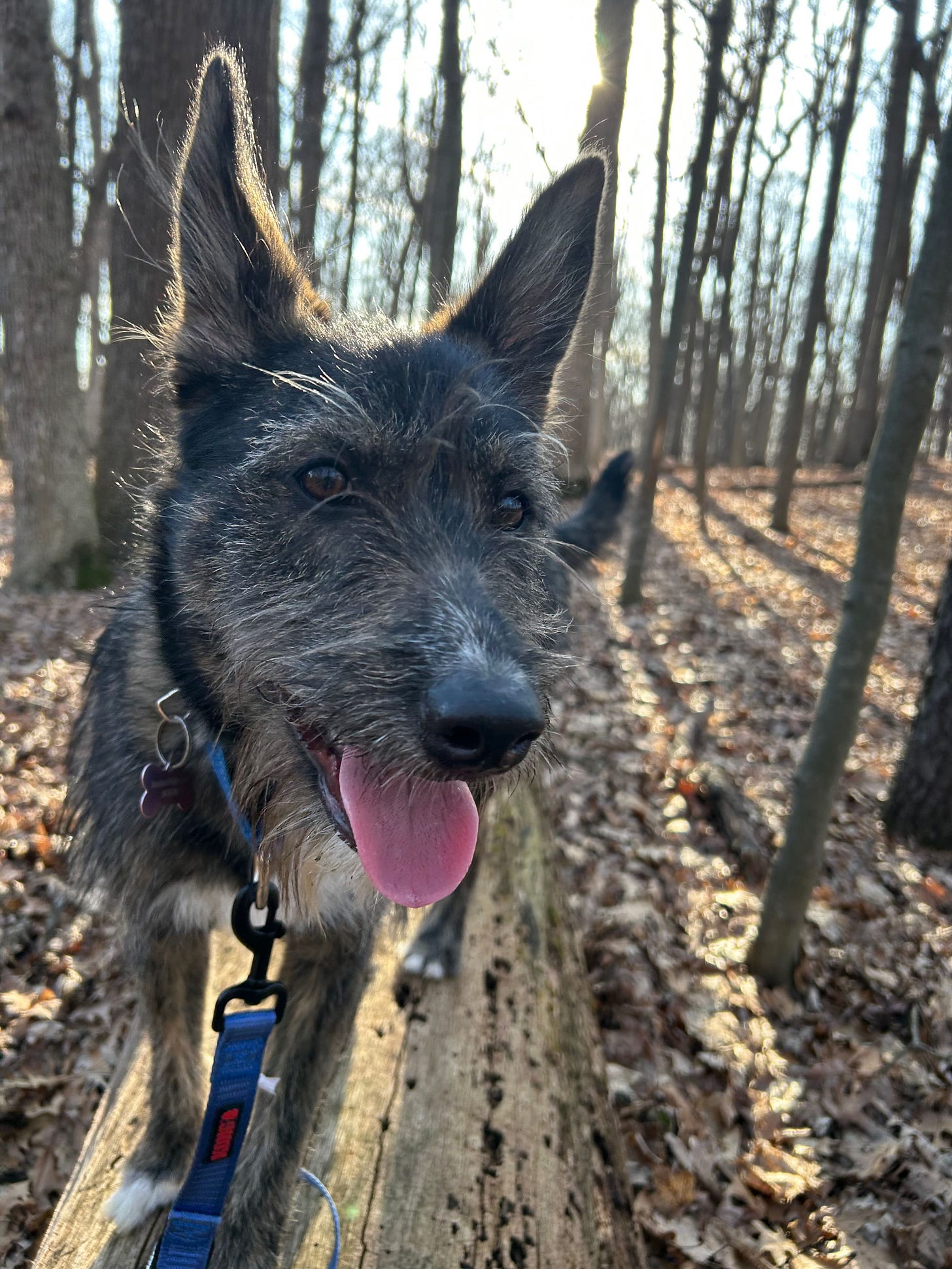
Such a beautiful read and meditation, Michelle. Thank you for taking us into Heart Wood with you.
I especially like the word "Kin-dom" ❤️❤️
Well said! "The path ahead is not an easy one, but it is more manageable when we gather together." This is a much better idea than mine, which is to go hide in the woods, off the grid, in a log cabin with 1000 books! The beautiful blooming nature around me gives me hope that we will prevail over this time of vile depravity that we currently live in. May 4th was the 55 anniversary of the massacre at Kent State. I lived only 50 miles away in a community full of Kent State graduates. I am reminded of another time when we thought there was no end to the evil our own government perpetuated upon us. Somehow it ended and most people realized it was all wrong. When I went to Kent State four years later people booed us and gave us the finger when we drove by in a Kent State bus. We did not wear Kent State T-shirts. I don't even think they were sold in the bookstore. Now, 55 years later most people would say what happened that day on the Kent State campus was wrong and should never have happened. I hope we can prevail again, and in the future people will look back at this as a time that never should have happened.